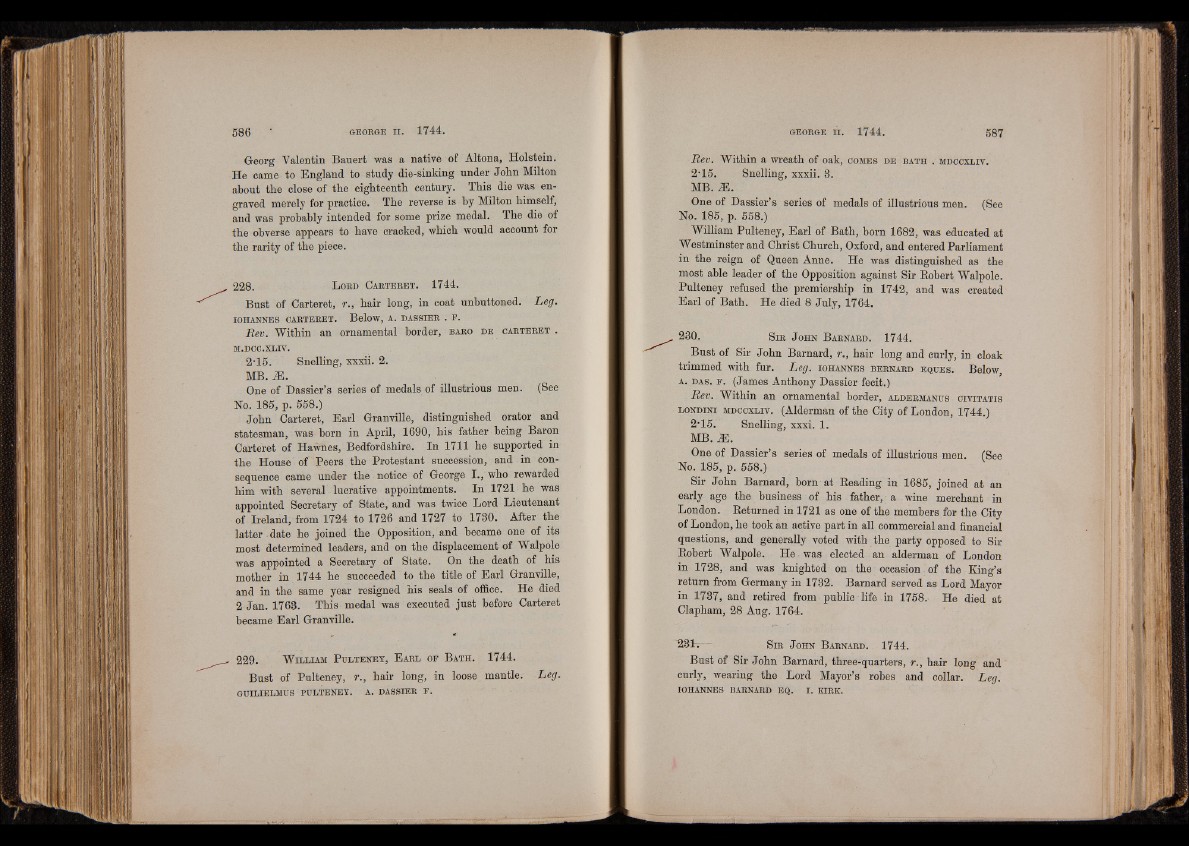
Georg Valentin Bauert was a native of Altona, Holstein.
He came to England to study die-sinking under John Milton
ahout the close of the eighteenth century. This die was engraved
merely for practice. The reverse is by Milton himself,
and was probably intended for some prize medal. The die of
the obverse appears to have cracked, which would account for
the rarity of the piece.
228. L o ed Ca r t e r e t . 1744.
Bust of Carteret, r., hair long, in coat unbuttoned. Leg.
IOHANNES CAETEEET. Below, A. DASSIEE . F.
Lev. Within an ornamental border, baeo d e c a e t e e e t .
M.DCC.XLIV.
2-15. Snelling, xxxii. 2.
MB. M.
One of Dassier’s series of medals of illustrious men. (See
No. 185, p. 558.) . ; . .
John Carteret, Earl Granville, distinguished orator and
statesman, was born in April, 1690, his father being Baron
Carteret of Hawnes, Bedfordshire. In 1711 he supported in
the House of Peers the Protestant succession, and in consequence
came under the notice of George I., who rewarded
him with several lucrative appointments. In 1721 he was
appointed Secretary of State, and was twice Lord Lieutenant
of Ireland, from 1724 to 1726 and 1727 to 1730. After the
latter . date he joined the Opposition, and became one of its
most determined leaders, and on the displacement of Walpole
was appointed a Secretary of State. On the death of his
mother in 1744 he succeeded to the title of Earl Granville,
and in the same year resigned his seals of office. He died
2 Jan. 1763. This medal was executed just before Carteret
became Earl Granville.
2 2 9 . W il l ia m P u l t e n e v , E a r l o f B a t h . 1 7 4 4 .
Bust of Pulteney, r., hair long, in loose mantle. Leg.
GUILLELMUS PULTENEV. A. DASSIEE F.
Rev. Within a wreath of oak, come s d e b a th . m d c c x l iv .
2-15. Snelling, xxxii. 3.
MB. M.
One of Dassier’s series of medals of illustrious men. (See
No. 185, p. 558.)
William Pulteney, Earl of Bath, born 1682, was educated at
Westminster and Christ Church, Oxford, and entered Parliament
in the reign of Queen Anne. He was distinguished as the
most able leader of the Opposition against Sir Robert Walpole.
Pulteney refused the premiership in 1742, and was created
Earl of Bath. He died 8 July, 1764.
230. S i e J o h n B a r n a r d . 1744.
Bust of Sir John Barnard, r., hair long and curly, in cloak
trimmed with fur. Leg. io h a n n e s Ber n a r d e q u e s . Below
A. d a s . f . (James Anthony Dassier fecit.)
Lev. Within an ornamental border, a ld e em a n u s c iv it a t is
l o n d in i m d c c x l iv . (Alderman of the City of London, 1744.)
2*15. Snelling, xxxi. 1.
MB. M.
One of Dassier’s series of medals of illustrious men. (See
No. 185, p. 558.)
Sir John Barnard, born at Reading in 1685, joined at an
early age the business of his father, - a wine merchant in
London. Returned in 1721 as one of the members for the City
of London, he took an active part in all commercial and financial
questions, and generally voted with the party opposed to Sir
Robert Walpole. He was elected an alderman of London
in 1728, and was knighted on the occasion of the King’s
return from Germany in 1732. Barnard served as Lord Mayor
in 1737, and retired from public life in 1758. He died at
Clapham, 28 Aug. 1764.
^3L— S ir J o h n B a rna rd . 1744.
Bust of Sir John Barnard, three-quarters, r., hair long and
curly, wearing the Lord Mayor’s robes and collar. Leg.
IOHANNES BARNAED EQ. I . KIRK.